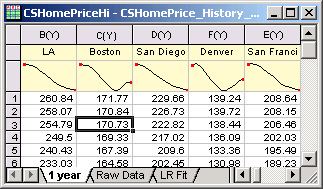Developer(s) OriginLab Corporation Type Data analysis | Operating system License Proprietary | |
 | ||
Stable release 2017 SR0 / November 10, 2016; 4 months ago (2016-11-10) Available in English, German, and Japanese. | ||
Origin is a proprietary computer program for interactive scientific graphing and data analysis. It is produced by OriginLab Corporation, and runs on Microsoft Windows. It has inspired several platform-independent open-source clones like QtiPlot or SciDAVis.
Contents
Graphing support in Origin includes various 2D/3D plot types.
Data analyses in Origin include statistics, signal processing, curve fitting and peak analysis. Origin's curve fitting is performed by the nonlinear least squares fitter which is based on the Levenberg–Marquardt algorithm.
Origin imports data files in various formats such as ASCII text, Excel, NI TDM, DIADem, NetCDF, SPC, etc. It also exports the graph to various image file formats such as JPEG, GIF, EPS, TIFF, etc. There is also a built-in query tool for accessing database data via ADO.
Features
Origin is primarily a GUI software with a spreadsheet front end. Unlike popular spreadsheets like Excel, Origin's worksheet is column oriented. Each column has associated attributes like name, units and other user definable labels. Instead of cell formula, Origin uses column formula for calculations.
Recent versions of Origin have introduced and expanded on batch capabilities, with the goal of eliminating the need to program many routine operations. Instead the user relies on customizable graph templates, analysis dialog box Themes which save a particular suite of operations, auto recalculation on changes to data or analysis parameters, and Analysis Templates™ which save a collection of operations within the workbook.
Origin also has a scripting language (LabTalk) for controlling the software, which can be extended using a built-in C/C++-based compiled language (Origin C). Other programming options include an embedded Python environment, and an R Console plus support for Rserve.
Origin can be also used as a COM server for programs which may be written in Visual Basic .NET, C#, LabVIEW, etc.
Origin project files (.OPJ) can be read by the open-source library liborigin.
There is also a free component (Orglab) maintained by Originlab that can be used to create (or read) OPJ files. A free Viewer application is also available .
Editions and support
Origin is available in two editions, the regular version Origin and the pricier OriginPro. The latter adds additional data analysis features like surface fitting, short-time Fourier Transform, and more advanced statistics.
Technical support is available to registered users via e-mail, online chat, and telephone. A user forum http://originlab.com/forum is also available, and posts are routinely answered by OriginLab staff and others in the user community.
History
Origin was first created for use solely with microcalorimeters manufactured by MicroCal Inc. (acquired by Malvern Instruments in 2014) The software was used to graph the instruments data, and perform nonlinear curve fitting and parameter calculation.
The software was first published for the public in 1992 by Microcal Software, which later was renamed to OriginLab Corporation, located in Northampton, Massachusetts.
Release history
Alternatives and clones
Similar proprietary software includes:
Open-source projects inspired by Origin:
Other open-source graphing and data analysis software:
